|
|
Balancing the Tire
Tools Needed: Tire balancer of choice, pliers, hammer, assorted size spoke weights.
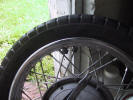 To properly balance the tire, you must first find the heavy "spot" on the rim. Remove the old spoke weights with a pliers and hammer... |
 ...place the pliers at the base of the spoke weight... |
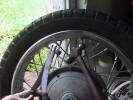 ...and tap the pliers with the hammer to knock the spoke weight free. Remove the weight by sliding the spoke through the slot in the weight. |
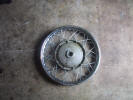 Break down the wheel as shown in the section above, "Dismounting & Remounting the Tire". Clean the wheel of all dirt and grease. Remove the rim strip. This is also a good time to tension the spokes and True the rim. |
 Use whatever balancer you prefer. You can make a homemade one or one professionally made. I use one made by Rod Neff. The better your balancer, the longer your tire will last and the smoother your ride will be. |
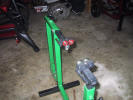 Rod's balancer uses ABEC-5 rollerblade bearings and is very sensitive. The bearings are easily replaced and are readily available. ABEC-7's can be used but I found them to be too sensitive. |
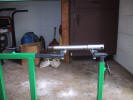 Rod's balancer is adjustable and can fit any type of axles, wheels and tires. I have even used it to balance crankshafts. Remember, the more accurate your balancer; the longer your tires will last. |
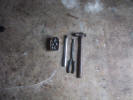 You'll need an assortment of spoke weights, an axle, pliers, and a hammer. |
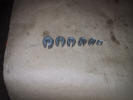 Spoke weights come in 1&1/2, 1, 3/4, 1/2 and 1/4 oz. sizes. If you want to get anal, you can cut them down to 1/8 oz. or less like the one on the right end. |
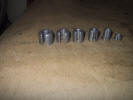 A profile view showing the spoke slot for mounting the weights. Spoke weights are not easy to find and cost upwards of $2 each when you find them. |
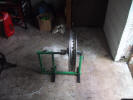 Slip the axle through the wheel and place it on the balancer. Make sure the axle is level and the balancer is on a level surface. |
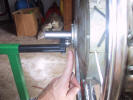 Make sure as the wheel spins it is not dragging on the left or... |
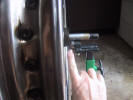 ...right side of your balancer. Allow the wheel to spin freely and let the heavy "spot" find bottom. |
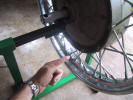 Once the wheel settles out and you are satisfied the heavy "spot" of the rim has been found; mark it so you can always find it. I use a dab of paint. |
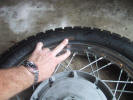 Now, remount the tire with the tires "light spot" mark aligned with the "heavy spot" on the rim. This way you will use the least amount of spoke weight when balancing. |
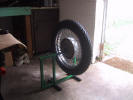 Again put the axle through the wheel and place the assembly on the balancer and let gravity do its thing. There is no need to spin the wheel. If it turns more than 2 revolutions you are wasting time. Dampen the spins with a finger until the heavy spot settles at the bottom. |
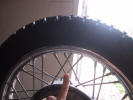 Pick the spoke closest to the 12 o'clock position and... |
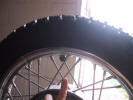 ...place the heaviest weight you have on that spoke, just finger tight is good enough. Steady the wheel and let it go. If the spoke weight goes to the bottom you are using too much weight. If the wheel does not move, you either got lucky and have the correct amount...or more likely...you need to add more. |
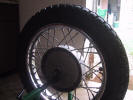 Add or remove weight (add to the next spoke left or right) until you can place the spokes weights at the 12, 3... |
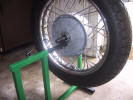 ...6... |
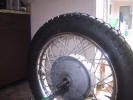 ...and 9 o'clock position with little or no movement of the wheel. The wheel is now balanced. Using Russian tires, I have used as much as 6&1/2 oz. and as little as 1/8 oz. to balance a wheel. I have just started using the DURO's and so far have only needed 1 oz. to balance. |
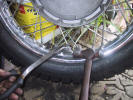 When you are satisfied, carefully remove the wheel from the balancer and use the pliers and hammer to seat the spoke weights on the nipple. |
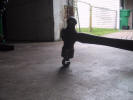 When re-using spoke weights, you may need to lightly tap the weight as above to close the slot so the weight fits snuggly on the nipple. |
When using a sensitive balancer such as the Rod Neff model, it is very easy to chase your tail. This balancer out of the box will be accurate to 1 gram or less. To give you an idea, the metal valve stem cap weighs 4 grams. So don't get too carried away. You can accumulate more grease and dirt on your rim than that. One pebble in the tread can weigh more. A few grams out of balance for our type of riding is nothing to worry over. |
|